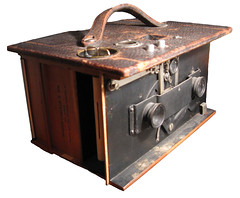Difference between revisions of "No. 2 Stereo Kodak"
m (added missing attribution & rights; fixed bad clickthrough on first pic; straightened out first graf) |
m |
||
| Line 19: | Line 19: | ||
</center> | </center> | ||
</div> | </div> | ||
| − | The '''No. 2 Stereo Kodak Camera''' was the first stereo camera manufactured by the [[Kodak|Eastman Kodak Co | + | The '''No. 2 Stereo Kodak Camera''' was the first stereo camera manufactured by the [[Kodak|Eastman Kodak Co]]. This camera shows patent dates of May 5, 1885, December 1, 1891; Sept. 25, 1894 and January 12, 1897. |
The No. 2 Stereo Kodak camera was on the market from 1901 to 1905 and sold for $15, its design echoes the [[No. 2 Bulls-Eye]], but is larger in width to accommodate the twin rectilinear lenses which made the stereo photographic feature possible. This camera could also be used as a single lens camera by sliding a cap over one lens. | The No. 2 Stereo Kodak camera was on the market from 1901 to 1905 and sold for $15, its design echoes the [[No. 2 Bulls-Eye]], but is larger in width to accommodate the twin rectilinear lenses which made the stereo photographic feature possible. This camera could also be used as a single lens camera by sliding a cap over one lens. | ||
Revision as of 16:55, 17 July 2011
No. 2 Stereo Kodak

|
| image by lauraseuss (Image rights) |

|
| image by lauraseuss (Image rights) |
The No. 2 Stereo Kodak Camera was the first stereo camera manufactured by the Eastman Kodak Co. This camera shows patent dates of May 5, 1885, December 1, 1891; Sept. 25, 1894 and January 12, 1897.
The No. 2 Stereo Kodak camera was on the market from 1901 to 1905 and sold for $15, its design echoes the No. 2 Bulls-Eye, but is larger in width to accommodate the twin rectilinear lenses which made the stereo photographic feature possible. This camera could also be used as a single lens camera by sliding a cap over one lens.
The No. 2 Stereo Kodak camera is a roll film camera that uses paper-backed 101 film that produces six 3 ½ ” × 6 ” images per roll. Features include two red windows for the number indicators of the film, a timed-shot shutter button, tripod attachment and spirit level.